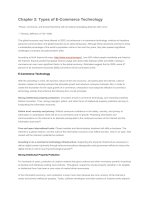Business analytics methods, models and decisions evans analytics2e ppt 11
Bạn đang xem bản rút gọn của tài liệu. Xem và tải ngay bản đầy đủ của tài liệu tại đây (5.96 MB, 63 trang )
Chapter 11
Spreadsheet Modeling
and Analysis
Predictive Decision Modeling
Predictive modeling is the heart and soul of
business decisions.
Building decision models is more of an art than a
science.
Creating good decision models requires:
- solid understanding of business functional areas
- knowledge of business practice and research
- logical skills
It is best to start simple and enrich models as
necessary.
Strategies for Predictive Decision
Modeling
Simple mathematics
◦ “Back-of-the-envelope” calculations can provide the
basis for a more formal model
Influence diagrams
◦ Introduced in Chapter 1, an influence diagram is a logical
and visual representation of key model relationships
Example 11.1: The Economic Value of a
Customer
A restaurant customer dines 6 times a year and spends
an average of $50 per visit.
The restaurant realizes a 40% margin on the average bill
for food and drinks.
Annual gross profit on a customer = $50(6)(0.40) = $120
30% of customers do not return each year.
Average lifetime of a customer = 1/0.3 = 3.33 years
Average gross profit during a customer’s lifetime =
$120(3.33) = $400
Developing a General Model for Example
11.1
V = value of a loyal customer
R = revenue per purchase
F = purchase frequency (number of visits per year)
M = gross profit margin (expressed as a fraction)
D = defection rate (fraction of customers not
returning each year)
Example 11.2: Developing a Decision Model Using
an Influence Diagram
Cost = fixed cost + variable cost
P = profit
R = revenue
C = F + cQ
C = cost
Revenue = price times quantity sold
R = pS
Quantity sold = Minimum{demand, quantity sold}
S = min{D, Q}
Profit = Revenue − Cost
P = p*min{D, Q} − (F + cQ) (11.2)
p = unit price
c = unit cost
F = fixed cost
S = quantity sold
D = demand
Q = quantity
produced
Implementing Models on
Spreadsheets
Principles of good spreadsheet design:
◦ Separate the data, model calculations, and model
outputs clearly in designing a spreadsheet.
◦ Do not use input data in model formulas, but reference
the spreadsheet cells that contain the data. In this way, if
the data change or you want to experiment with the
model, you need not change any of the formulas, which
can easily result in errors.
Example 11.3: A Spreadsheet Model for
the Outsourcing Decision
(Example 1.8 in Chapter 1)
The scenario involves a manufacturer who can produce
a part for $125/unit with a fixed cost of $50,000. The
alternative is to outsource production to a supplier at a
unit cost of $175.
Models for total cost:
Example 11.3 Continued
Excel spreadsheet
Example 11.4: Pricing Decision
Spreadsheet Model
A firm wishes to determine the best pricing for one of its
products to maximize revenue.
◦ Sales = -2.9485 × price + 3,240.9
◦ Total revenue = price × sales
= price × (-2.9485 × price + 3,240.9)
= -2.9485 × price2 + 3,240.9 × price
Example 11.5: Spreadsheet Implementation of
the Profit Model
Assume that unit price = $40, unit cost = $24, fixed cost =
$400,000, and demand = 50,000.
The decision variable is the quantity produced; assume a value of
40,000 units.
Spreadsheet Quality
Building spreadsheet models (called spreadsheet
engineering) is part art and part science.
Spreadsheets need to be
◦ accurate,
◦ understandable, and
◦ user friendly.
Verification is the process of ensuring that a model is
accurate and free from logical errors.
Improving Spreadsheet Quality
Improve the design and format of the spreadsheet itself.
◦ Sketch a logical design of the spreadsheet.
◦ Break complex formulas into smaller pieces
◦ Design the spreadsheet in a form that the end user can easily
interpret and understand
Improve the process used to develop a spreadsheet.
◦ Work on one part at a time
◦ Check formula results with simple numbers
Inspect your results carefully and use appropriate tools
available in Excel.
◦ Use Excel auditing tools
Example 11.6: Modeling Net Income on a
Spreadsheet
Gross profit = sales – cost of goods sold
Operating expenses = administrative expenses
+ selling expenses
+ depreciation expenses
Net operating income = gross profit
– operating expenses
Earnings before taxes = net operating income
– interest expense
Net income = earnings before taxes – taxes
Example 11.6 Continued
Simple model:
◦ net income = sales - cost of goods sold - administrative expenses
- selling expenses – depreciation expenses - interest expense taxes
Example 11.6 Continued
Data-model format
Example 11.6 Continued
Pro forma income statement
Spreadsheet Applications in Business
Analytics
A wide variety of practical problems in business
analytics can be modeled using spreadsheets.
A useful spreadsheet model need not be complex;
often, simple models can provide managers with the
information they need to make good decisions.
Example 11.7: A Predictive Model for
Staffing
The manager of a loan processing department
wants to know how many employees will be
needed over the next several months to
process a certain number of loan files per
month so she can better plan capacity.
Different types of products, such as a 30-year
fixed rate mortgage, 7/1 ARM, FHA loan, or a
construction loan, each varying in complexity
and time to complete.
Data:
◦ Forecasts: 700 loan applications in May, 750 in June, 800
in July, and 825 in August.
◦ Each employee works productively for 6.5 hours each
day, and there are 22 working days in May, 20 in June, 22
in July, and 22 in August.
Predict the number of full time equivalent (FTE) staff needed each
month to ensure that all loans can be processed.
Example 11.7 Continued
Spreadsheet Model
Models Involving Multiple Time
Periods
Many practical models incorporate multiple time periods
that are logically linked together.
Taking a systematic approach to putting the pieces
together logically can often make a seemingly difficult
problem much easier.
Example 11.8: New-Product Development
Moore Pharmaceuticals needs to decide whether to
conduct clinical trials and seek FDA approval for a newly
developed drug.
R&D cost = $700 million
Clinical trials cost = $150 million
Market size = 2 million people
Market size growth = 3% per year
Market share = 8%
Market share growth = 20% per year
Monthly revenue/prescription = $130
Monthly variable cost/prescription = $40
Discount rate = 9%
Example 11.8 Continued
Spreadsheet Model
Example 11.8 Continued
Spreadsheet Formulas
Single-Period Purchase Decisions
One-time purchase decisions often must be made in the
face of uncertain demand.
Newsvendor Problem: How many newspapers to
purchase each day?
C = cost to purchase a newspaper
Q = number of newspapers the vendor purchases
D = number of newspapers demanded
R = revenue from selling a newspaper
S = salvage value of unsold newspapers
Net profit = R × quantity sold + S × surplus quantity – C ×Q
= R(min{Q,D}) + S(max{0,Q−D}) − CQ









